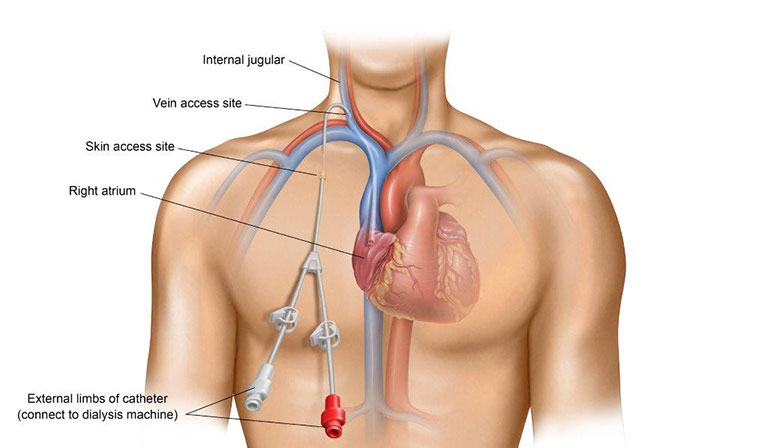Tunneled Central Line Dialysis Catheter
What is it?
- A central venous line is a catheter that is inserted into a vein of the neck that connects to the heart. There are a variety of configurations and sizes of catheters that are placed.
Why is it done?
- A central line is necessary when a patient needs medications given through their veins over an extended period of time. It is easier and less painful to have a central line placed than having to put a needle into a patient’s vein each time they need therapy. Central lines are preferred over traditional IV’s because they can stay in place longer, it is easier to draw blood from, and it allows for a wider range of medications to be administered.
How is it performed?

- Typically you are positioned laying on a bed.
- The skin around the procedure site is cleaned. A local numbing medicine (anesthetic) is injected into the skin. In addition to the local numbing medication, a “cocktail” of IV medication is given to relax the patient and keep them comfortable.
- A needle is placed through the skin and into a vein of the neck (typically the right internal jugular vein) which creates a small tunnel.
- A wire is advanced through the tunnel. Fluoroscopy is used to watch the position of the wire and confirm the correct location.
- A hollow sheath is advanced over the wire. Once in position, the central line is advanced through the sheath. Again, position is confirmed with fluoroscopic imaging.
- The sheath is removed and the central line is sutured and bandaged in place.
What should I expect?
- You may be asked to hold certain medications in preparation of your procedure.
- During the procedure, you may be asked to hold your breath for short periods of time or to reposition your head in order to ease the process of gaining venous access.
- As the central line is being placed, you may experience moments of discomfort or pressure in your neck.
What is my recovery time?
- Typically any symptoms you experience during or after your procedure should dissipate in 1-2 hours.
- Avoid strenuous activity for 48 hours.
- If you develop increased pain post procedure, seek immediate medical attention.
Possible Risks/Complications
- Although generally considered a low-risk intervention, complications of central line placement include: bleeding at puncture site, infection, puncturing an artery, hematoma formation, and developing a pneumothorax.
